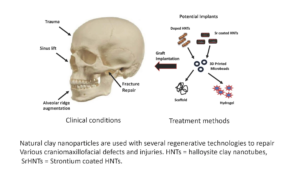NEWS
Louisiana Tech professor of biological sciences Dr. David Mills is the principal investigator (PI) on an Interdisciplinary Translational Project (ITP) team that has received a 2019 grant award to aid in their development of a microbead that can help in the treatment of craniomaxillofacial clinical conditions. First-year funding was awarded for $148,000.
 The project, “3D Printed Nanoclay Enhanced Calcium Phosphate Ceramic Composite,” will develop a 3D-printed, calcium phosphate microbead with tunable properties, sustained drug release, and increased material strength. The composite will deliver antimicrobials and osteogenic agents designed to induce osteogenesis, control infection, and produce a reparative tissue. It will be designed for use in infection prevention, tissue regeneration, and treatment of various bone diseases.
The project, “3D Printed Nanoclay Enhanced Calcium Phosphate Ceramic Composite,” will develop a 3D-printed, calcium phosphate microbead with tunable properties, sustained drug release, and increased material strength. The composite will deliver antimicrobials and osteogenic agents designed to induce osteogenesis, control infection, and produce a reparative tissue. It will be designed for use in infection prevention, tissue regeneration, and treatment of various bone diseases.
When completed, this system will offer streamlined care, an integrated diagnosis, and design and on-site manufacturing that will deliver fast, effective, and affordable treatment.
The grant was awarded by the Center for Dental, Oral, & Craniofacial Tissue and Organ Regeneration (C-DOCTOR); the organization is funded by the National Institute of Dental and Craniofacial Research and represents a partnership among several California institutions, headed by faculty at USC, UC San Francisco/Berkeley/Davis, UCLA, and Stanford.
C-DOCTOR serves as a national resource for the clinical translation of innovative technologies to regenerate dental and craniofacial tissues and organs lost to congenital disorders, trauma, and disease. C-DOCTOR’s comprehensive resources and infrastructure are used to support ITP teams throughout the product development cycle, from conception to commercialization.
Mills’ and his co-PI, Dr. Bingyun Li from the University of West Virginia, were one of the teams awarded the grant after a nationwide competition from universities and industry.
In Mills’ BioMorph Laboratory in Tech’s on-campus Center for Biomedical Engineering Research and Rehabilitation Science, students learn concepts and do research make discoveries similar to the dynamics of Mills’ current project with C-DOCTOR. Here are some of the uses of the BioMorph Laboratory:
- designing novel and dynamic nanofilms (biodegradable, bioactive, micropatterned) for cell adhesion, differentiation and functionality;
- nanoassembly for dental & orthopedic implants;
- layer-by-layer assembly for cell encapsulation;
- application of nanoscale topographic and chemical cues for controlling chondro- and osteogenesis;
- understanding complex soft tissue modeling during development and remodeling in response to altered joint mechanics;
- structure-function relationships in TMJ soft tissues and engineering tissues for TMJ repair or replacement.